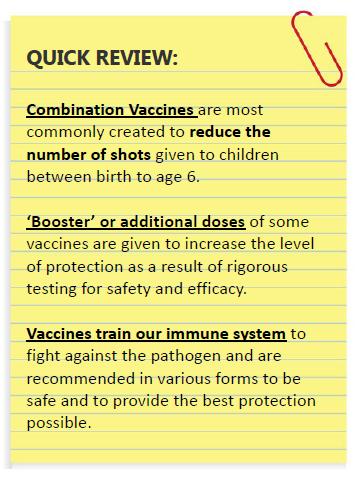In the fifth installment of the Immunology 101 Series, Aimee will explain why some vaccines are given together as combination vaccines and why some vaccines need one or more booster shots to provide complete protection. As you may recall from earlier blog posts, vaccines are created after years of research and undergo several phases of testing to be deemed safe and effective. All of this holds true for combination vaccines as well as those that require boosters – they are recommended in various forms to be safe and to provide the best protection possible.
While visiting your pediatrician or reviewing the American Academy of Pediatrics Immunization Schedule, you may have wondered why some vaccines are combined and why some vaccines need one or more booster shots at a later date. The answers to these questions can be found below – read on to find out more!
Why are some vaccines given together as combination vaccines?
There are a variety of reasons why some vaccines are given together as combination vaccines. One of the main reasons is to reduce the number of shots a child will receive between birth and age six. Science and medicine have made great strides in recent years and the number of new and improved vaccines now available to prevent childhood disease has increased. In response, some vaccines have been combined simply to reduce the number of shots a child will need within his or her first six years of life. Some examples of combined vaccines are the MMR for Measles, Mumps, and Rubella and the DTaP for Diphtheria, Tetanus, and Pertussis.
As most parents know, some visits to the pediatrician’s office result in up to four separate injections. If combination vaccines were not available, the number of injections would more than double for each visit. As an immunologist, vaccine advocate and wife of a pediatrician, I adhere to and understand the structure of the recommended immunization schedule. However, as a mother I must admit that even I would be hesitant to submit my children to 10+ separate shots per
visit if the combination vaccines didn’t exist. It’s tough to watch your children receive injections, even when it’s done smoothly. I’ve watched many times as four medical staff swoop in to the exam room to administer the injections all at once to the child sitting on my lap. Thanks to their orchestration and synchronized administration, they are in and out of the room before my children have time to notice what happened. Of course, the last one out the door stops briefly to offer an assortment of lollipops. As every parent knows, this offering magically elevates the mood in the room from one of slight confusion to sugary happiness. I am grateful that combination vaccines exist to make trips like these easier for both children and parents.
Other reasons why some vaccines have been combined are slightly less exciting to parents but include advantages to the health care provider and parents, such as reducing the cost of stocking and administering separate vaccines if combination vaccines did not exist, reducing the number of health-care visits needed if all vaccines were separate and not combined, and facilitating the addition of new vaccines for newly preventable diseases into the recommended immunization schedule.
Another important point to make is that vaccine antigens (the pathogenic components used to produce an immune response that will provide long-lasting protection) are only combined after they have been tested for compatibility and have proven to be completely safe and effective for use together as one combined vaccine.
Why do some vaccines require more than one dose?

Sawyer shows off her band-aid after receiving her annual flu vaccination. Flu vaccines are recommended each year because the virus continually changes.
There are several reasons why some vaccines are given as a single dose and others require multiple doses. One reason is that during testing for efficacy (i.e. how effective the vaccine is) some vaccines were found to provide a moderate level of
protection after a single dose but additional ‘booster’ doses were found to significantly increase the level of protection. When researchers discovered that the level of protection of some vaccines was enhanced with additional ‘booster’ doses, recommendations for additional doses were put into place. An example of a vaccine that requires multiple doses is the vaccine for Haemophilus influenzae type b or Hib.
Another vaccine that requires an annual dose is the vaccine for the influenza virus (the ‘flu’). As most parents know, an immunization against influenza is recommended by the CDC for everyone 6 months and older every year. This is for a slightly different reason – influenza is a virus that continually changes. Each year the virus changes so much that we need to be immunized against the new strains or forms of the virus that are most prevalent that given year. If you read the second blog in the Immunology 101 Series: 5 Ways Vaccines are Made, you may recall that scientists use the unique 
Stay tuned for the next Immunology 101 Series post to learn more about the answer to this commonly asked question: “Does giving multiple vaccines at one visit overwhelm the immune system?”
Spoiler alert: The answer is NO!
SOURCES:
1. CDC Morbidity and Mortality Weekly Report (MMWR) May14, 1999 / 48(RR05);1-15
2. The Children’s Hospital of Philadelphia Vaccine Education Center http://www.chop.edu/service/vaccine-education-center/home.html

